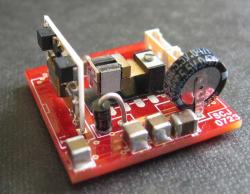Microgenerator developed using vibrations as a power source
Employees of the University of Southampton (UK) developed a generator that collects electromagnetic energy of oscillations. According to the developers, a new microgenerator can be used to provide energy for wireless sensors and even medical implants.

The generator is able to convert up to 30% of the kinetic energy of the environment into electricity. It can provide various kinds of low-power devices in the case when alternative power sources (for example, solar energy) are not available.
A microgenerator collects energy using the swaying of several magnets mounted on a bracket no larger than a millimeter in size. Without going into scientific details, the principle of operation of the generator can be described as follows. “Responding” to the vibration, the bracket begins to swing up and down. The magnets attached to it also begin to move, and the magnetic field created by them is used to generate electrical energy. British scientists are not without pride declare that their development is the most effective of all existing microgenerators.
When testing the generator in laboratory conditions, taking into account the vibrations generated by such a structure as a bridge, the device was able to generate 46 microwatts of electricity. According to Steve Bibi (project manager and the team that developed the microgenerator), this energy is enough to power small devices, such as sensors. Of course, such a small amount of energy is not enough to ensure the operation of the phone or MP3 player. But in the near future, the use of a microgenerator is possible in medical implants, such as, for example, an electronic heart stimulator. In this case, the source of oscillations will be the heartbeat. Great symbiosis. The heart "feeds" the generator, the generator ensures its operation ...
')
via NewScientistTech

The generator is able to convert up to 30% of the kinetic energy of the environment into electricity. It can provide various kinds of low-power devices in the case when alternative power sources (for example, solar energy) are not available.
A microgenerator collects energy using the swaying of several magnets mounted on a bracket no larger than a millimeter in size. Without going into scientific details, the principle of operation of the generator can be described as follows. “Responding” to the vibration, the bracket begins to swing up and down. The magnets attached to it also begin to move, and the magnetic field created by them is used to generate electrical energy. British scientists are not without pride declare that their development is the most effective of all existing microgenerators.
When testing the generator in laboratory conditions, taking into account the vibrations generated by such a structure as a bridge, the device was able to generate 46 microwatts of electricity. According to Steve Bibi (project manager and the team that developed the microgenerator), this energy is enough to power small devices, such as sensors. Of course, such a small amount of energy is not enough to ensure the operation of the phone or MP3 player. But in the near future, the use of a microgenerator is possible in medical implants, such as, for example, an electronic heart stimulator. In this case, the source of oscillations will be the heartbeat. Great symbiosis. The heart "feeds" the generator, the generator ensures its operation ...
')
via NewScientistTech
Source: https://habr.com/ru/post/11995/
All Articles